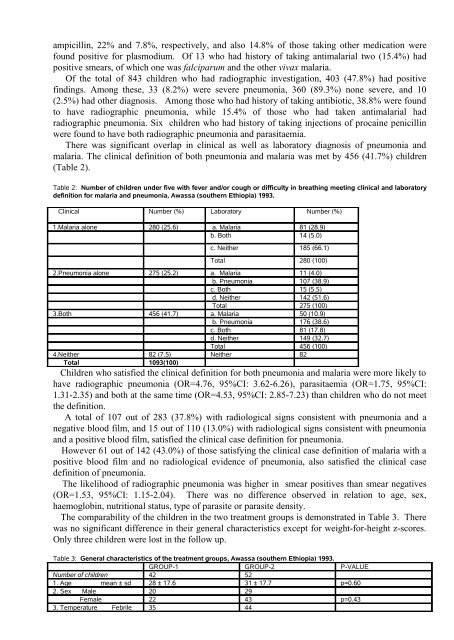Original article - Ethiopian Review
Original article - Ethiopian Review
Original article - Ethiopian Review
- No tags were found...
You also want an ePaper? Increase the reach of your titles
YUMPU automatically turns print PDFs into web optimized ePapers that Google loves.
ampicillin, 22% and 7.8%, respectively, and also 14.8% of those taking other medication werefound positive for plasmodium. Of 13 who had history of taking antimalarial two (15.4%) hadpositive smears, of which one was falciparum and the other vivax malaria.Of the total of 843 children who had radiographic investigation, 403 (47.8%) had positivefindings. Among these, 33 (8.2%) were severe pneumonia, 360 (89.3%) none severe, and 10(2.5%) had other diagnosis. Among those who had history of taking antibiotic, 38.8% were foundto have radiographic pneumonia, while 15.4% of those who had taken antimalarial hadradiographic pneumonia. Six children who had history of taking injections of procaine penicillinwere found to have both radiographic pneumonia and parasitaemia.There was significant overlap in clinical as well as laboratory diagnosis of pneumonia andmalaria. The clinical definition of both pneumonia and malaria was met by 456 (41.7%) children(Table 2).Table 2: Number of children under five with fever and/or cough or difficulty in breathing meeting clinical and laboratorydefinition for malaria and pneumonia, Awassa (southern Ethiopia) 1993.Clinical Number (%) Laboratory Number (%)1.Malaria alone 280 (25.6) a. Malaria 81 (28.9)b. Both 14 (5.0)c. Neither 185 (66.1)Total 280 (100)2.Pneumonia alone 275 (25.2) a. Malaria 11 (4.0)b. Pneumonia 107 (38.9)c. Both 15 (5.5)d. Neither 142 (51.6)Total 275 (100)3.Both 456 (41.7) a. Malaria 50 (10.9)b. Pneumonia 176 (38.6)c. Both 81 (17.8)d. Neither 149 (32.7)Total 456 (100)4.Neither 82 (7.5) Neither 82Total 1093(100)Children who satisfied the clinical definition for both pneumonia and malaria were more likely tohave radiographic pneumonia (OR=4.76, 95%CI: 3.62-6.26), parasitaemia (OR=1.75, 95%CI:1.31-2.35) and both at the same time (OR=4.53, 95%CI: 2.85-7.23) than children who do not meetthe definition.A total of 107 out of 283 (37.8%) with radiological signs consistent with pneumonia and anegative blood film, and 15 out of 110 (13.0%) with radiological signs consistent with pneumoniaand a positive blood film, satisfied the clinical case definition for pneumonia.However 61 out of 142 (43.0%) of those satisfying the clinical case definition of malaria with apositive blood film and no radiological evidence of pneumonia, also satisfied the clinical casedefinition of pneumonia.The likelihood of radiographic pneumonia was higher in smear positives than smear negatives(OR=1.53, 95%CI: 1.15-2.04). There was no difference observed in relation to age, sex,haemoglobin, nutritional status, type of parasite or parasite density.The comparability of the children in the two treatment groups is demonstrated in Table 3. Therewas no significant difference in their general characteristics except for weight-for-height z-scores.Only three children were lost in the follow up.Table 3: General characteristics of the treatment groups, Awassa (southern Ethiopia) 1993.GROUP-1 GROUP-2 P-VALUENumber of children 42 521. Age mean ± sd 28 ± 17.6 31 ± 17.7 p=0.602. Sex Male 20 29Female 22 43 p=0.433. Temperature Febrile 35 44




![to read the full report [pdf, Amharic] - Ethiopian Review](https://img.yumpu.com/52737829/1/190x245/to-read-the-full-report-pdf-amharic-ethiopian-review.jpg?quality=85)











